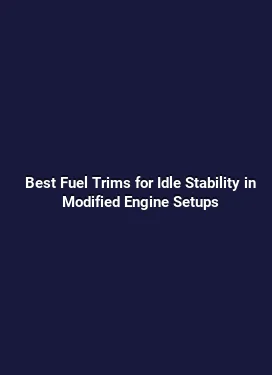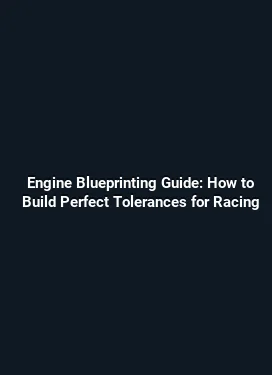Forged Pistons vs Cast Pistons for High Boost Applications: A Comprehensive Comparison Guide
Understanding Piston Fundamentals in High-Boost Contexts

In turbocharged and supercharged engines, piston selection significantly influences reliability, longevity, and performance when operating at elevated boost levels. Cast pistons are typically the baseline choice for many stock and mildly modified engines due to their cost efficiency and adequate performance within a conservative power envelope. Forged pistons, by contrast, are engineered for higher strength and resilience under demanding conditions such as increased boost pressures, higher cylinder pressures, and aggressive detonation management. This guide delves into the material science, mechanical behavior, and tuning implications that arise when selecting between forged and cast pistons for high-boost applications.
As boost pressure climbs, the combustion dynamics change. In practice, engineers and tuners consider not only peak power but also the margins against detonation, piston crown temperature, ring seal integrity, and skirt stability. The choice between forged and cast is thus a decision that balances cost, reliability, and the specificity of a given build, including bore size, compression ratio, fuel grade, and cooling strategy.
Material Science and Manufacturing Differences
Cast pistons are produced by allowing molten aluminum to solidify within a mold. The crystal structure tends to be varied and can contain intrinsic porosity or casting flaws. This results in a piston with acceptable strength for standard operating ranges but with limitations under high-heat, high-load scenarios common in tuned engines. Forged pistons, conversely, are created from a billet or ingot that is extruded or hammered into shape before finishing. The forging process aligns the metal grains, yielding superior fatigue resistance, reduced susceptibility to microcracking, and greater dimensional stability under thermal cycling. As a result, forged pistons can withstand higher peak cylinder pressures, improved ring seating behavior, and better resistance to tilt and deformation under boost-induced loads.
Beyond the raw material, the heat treatment and coating of pistons play a crucial role. Forged pistons often benefit from optimized thermal barriers, anodized faces, or ceramic coatings that manage heat flow away from the crown. Cast pistons may carry hypo-eutectic or hypereutectic alloys with different thermal conductivities and expansion characteristics. Understanding these differences helps explain why forged pistons can maintain piston-to-wall clearances at higher temperatures and why coating choices influence detonation tolerance and oil retention in high-boost environments.
Mechanical Behavior Under High Boost and Detonation Scenarios
Detonation resistance is a central concern when boosting engines. Forged pistons generally offer higher detonation resistance due to their improved material properties, but this does not erase the need for careful tuning. In a high-boost setup, cylinder pressure spikes during the compression and power strokes can induce bending moments and thermal stresses. Cast pistons may start to exhibit microcracking or localized yielding sooner than forged counterparts when operating near or beyond the recommended boost thresholds. By contrast, forged pistons tend to retain shape and seal integrity under similar conditions, assuming the rest of the engine supports the load—proper cooling, adequate lubrication, and robust ring packs.
Ring lands and crown geometry are critical areas where the difference between piston types becomes pronounced. Forged pistons are often designed with stronger ring lands and optimized crown recesses, enabling more aggressive compression ratios or higher boost without sacrificing ring seal. Proper ring tension and gap setting are essential for both piston types, but forged options may accommodate slightly tighter gaps or alternative ring materials with less risk of land collapse under heat and pressure.
Harmonic Behavior and Mechanical Clearances

The dynamic interaction between the piston, rings, and bore surface evolves as boost increases. Forged pistons typically exhibit lower susceptibility to thermal expansion mismatch due to more uniform grain structure, which translates to more predictable clearance behavior during rapid temperature swings. For tuners, this means a forged option can offer more room to dial in tighter ring gaps or optimized ring groove geometry to balance oil control with ring seal at high rpm and high load.
Impact on Boost, Tuning, and Engine Management Strategy
Engine management and tuning strategies must align with the chosen piston type. When upgrading to forged pistons, the tuner often has a wider operational window for increasing boost, provided supporting modifications are in place. This includes upgrading the cooling system, ensuring adequate lubrication supply, and selecting a compression ratio suitable for the intended fuel grade and octane. Cast pistons, on the other hand, frequently require more conservative boost targets or a reduction in compression to preserve reliability at the same power levels as forged builds.
From the control perspective, fuel delivery, ignition timing, and boost control strategies must be harmonized with the piston’s tolerance profile. For forged pistons, the tuning envelope can accommodate more aggressive ignition timing and controlled detonation management, often enabled by higher octane fuel, advanced knock detection, and refined boost control algorithms. Cast pistons may demand a more conservative approach, with emphasis on heat management, safe ignition margins, and robust fuel supply to maintain a stable air-fuel ratio under peak load.
Boost Targets, Detonation Margin, and Cooling Considerations
In high-boost builds, monitoring and managing detonation is essential regardless of piston type. Real-time knock sensing, progressive boost ramping, and temperature monitoring are part of a disciplined tuning workflow. Forged pistons may tolerate higher boost more comfortably, but this does not negate the need for careful detonation control. Efficient intercooling, effective charge air cooling, and consistent fuel quality are fundamental to maintaining safe operating conditions. Cast pistons can respond well to calibrated reductions in boost or more conservative timing strategies when octane or ambient conditions limit aggressive tuning.
Durability and Long-Term Reliability in Real-World Scenarios
Durability in high-boost builds hinges on the synergy between piston design, lubrication, cooling, and the rest of the drivetrain. Forged pistons often demonstrate superior fatigue resistance under repeated thermal cycles and higher load demands. This translates to lower risk of crown crack initiation, reduced likelihood of ring land failure, and more consistent piston-to-wall clearances over the life of the engine. Cast pistons can deliver long-term reliability within a limited high-boost range, especially when paired with conservative compression ratios and a well-optimized cooling system.
Practical reliability also depends on attention to ancillary systems: oil pressure stability, windage control, upper cylinder lubrication, and piston skirt wear. Forged options frequently benefit from upgraded oiling schemes, coatings that reduce friction, and careful skirt lubrication management to prevent scuffing under high rpm. In contrast, cast pistons might require stricter adherence to break-in procedures, precise oil selection, and monitoring for overheating or oil foaming under sustained high-load conditions.
Practical Selection Guidelines for Builders and Tuners
Choosing between forged and cast pistons for a high-boost build starts with a clear performance target and a realistic budget. The following guidelines summarize practical decision points, drawing on empirical experience from successful builds across various platforms.
- Assess the pre-existing engine architecture: bore size, compression ratio, and rod/piston clearance tolerances set the stage for piston choice.
- Define boost targets and fuel strategy: higher boost generally aligns with forged pistons, provided fuel and cooling systems are upgraded accordingly.
- Evaluate cooling capacity: a robust intercooling and radiator setup reduces crown heat, enabling safer operation with forged pistons at higher pressures.
- Plan lubrication strategy: high-velocity oil flow, reduced oil temperatures, and stable pressure curves support piston survivability under high load.
- Consider ring package and gap strategy: forged pistons often pair with optimized rings for improved seal and reduced blow-by at elevated temperatures.
- Factor in cost-to-benefit: forged pistons add price and installation complexity, but can deliver meaningful gains in reliability and high-boost performance.
Case Studies: Real-World Scenarios and Lessons Learned
Case studies illustrate how engine management decisions interact with piston selection. In a high-boost street application, a well-tuned engine built around forged pistons may sustain daily driving at 8-12 psi with wider operating margins for occasional track days, coupled with a robust air-to-water intercooler, a tuned ECU strategy, and high-octane fuel. Conversely, a dedicated drag-oriented build might leverage forged pistons with a higher compression ratio optimized for a controlled fuel mixture, enabling peak power while maintaining detonation suppression through precise control strategies and advanced data logging.
Engine builders should document the exact tuning steps used to reach target performance, including boost ramp profiles, dwell times on peak torque, and cooling system operating temperatures. This data-driven approach helps future-proof the build and provides a reference for maintenance intervals, piston ring replacement schedules, and potential porting or valve train upgrades to support higher RPM stability.
Lubrication, Cooling, and Detonation Control Integration
High-boost engines rely on reliable lubrication and effective cooling to preserve piston integrity. Forged pistons commonly benefit from upgraded oil passages, coatings that reduce friction, and improved oil film stability at high temperatures. The cooling system, including radiator capacity, intercooler efficiency, and oil cooler sizing, directly impacts crown temperature and overall detonation margin. Tuning strategies must align with these hardware choices to ensure the engine remains within safe operating envelopes under dynamic driving conditions.
Detonation control integrates with data-driven monitoring: fuel quality, octane rating, timing maps, and boost control strategies must respond to real-time feedback. Even when using forged pistons, poor cooling or inconsistent fuel supply can erode the advantages, underscoring the importance of holistic system optimization rather than a piston-centric approach alone.
Future Trends and Semantics: A Look Ahead
As boost environments become more sophisticated, piston technology continues to evolve with improved alloys, advanced coatings, and precision manufacturing processes. The industry increasingly favors dynamic tuning paradigms that adapt in real time to load, temperature, and fuel quality. For enthusiasts, this means staying informed about developments in ring technology, coating materials, and bore polishing techniques that can extend piston life and minimize friction losses.
From a semantic perspective, the emphasis is on understanding how each component—piston type, ring package, lubrication strategy, cooling capacity, and ignition timing—works together to achieve reliable high-boost performance. The practical takeaway is to approach a high-boost build as an integrated system where piston selection informs and is informed by tuning targets, cooling capacity, and fuel strategy, rather than as an isolated decision.
Conclusion-Free Practical Takeaways
Forged pistons offer a clear path to higher reliability under elevated boost levels and aggressive detonation management. Cast pistons remain a solid choice for engines operating within conservative boost ranges or with strict budget constraints. The best approach is to balance piston choice with a holistic upgrade plan that includes cooling, lubrication, fuel strategy, and a carefully tuned engine management map. By aligning these elements, a high-boost build can achieve meaningful performance gains while maintaining long-term durability across street and track use cases.
Makale içindeki ilk H3 başlık buraya gelmeli
Enhanced Detonation Control and Material Properties
Advanced detonation control requires integrating sensor data with adaptive timing strategies. Forged pistons, with their superior fatigue resistance and crown geometry, can accommodate more aggressive timing when paired with high-octane fuel, precise knock detection, and a robust intercooling system. This combination supports improved throttle response, quicker spool, and higher efficient power delivery without compromising piston integrity.
First H2 Section Focus
The initial sections of this guide lay the groundwork for understanding how material science, mechanical behavior, and tuning strategies influence performance outcomes in high-boost builds. The subsequent sections expand on practical steps, case considerations, and real-world decision criteria that builders can apply to their projects.
Planning Your Build: Documentation and Validation
Documenting the build plan, including piston type, ring package, compression ratio, fuel strategy, ignition table, and boost ramp profiles, is essential for repeatability and maintenance. Validation runs, temperature profiling, and data logging provide concrete evidence of how the chosen piston type performs under varied loads and ambient conditions. This disciplined approach helps ensure that the chosen piston technology aligns with the broader goals of efficiency, reliability, and performance in a high-boost environment.






